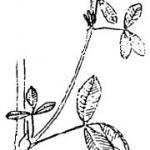Alfalfa
Description and Adaptation of Alfalfa (Medicago sativa)
Origin
Comes from Asia minor, a semi‐arid region where insufficient moisture is the chief limiting factor to plant growth. With little or no leaching, soils were neutral in reaction and generally well supplied with minerals. The name "alfalfa" comes from the Arabic language, meaning "best forage". Alfalfa was carried across North Africa and southern Europe to Spain, from Spain to the West Coast of South America, and from there to California about 1850.
Plant Characteristics:
Root system ‐ Long, thick, sparsely branched tap root with few small roots. Where soil conditions favor deep rooting, tap root may penetrate 15 to 20 feet. Deep rooting habit (where possible) makes alfalfa a very drought resistant plant. Lack of abundance of small feeding roots may account for part of the difficulty in getting satisfactory inoculation.
Stems ‐ Moderately strong, woody, upright stems high in fiber. For this reason and others, alfalfa is chiefly a hay and not a pasture plant. Stems arise from a "crown" or part of the plant close to the soil surface. The crown increases in size each year and may measure 12 inches or more in diameter. As a crop of stems begins to flower, new stems or "shoots" start to grow from the crown. This periodic development of new shoots (every four to six weeks during the growing season) explains why alfalfa is so productive. Two, three and even four crops can be harvested in one season. In the Imperial Valley in southern California, ten crops of alfalfa are harvested in one year.
Leaves ‐ Palatable and nutritious but can be easily lost during drying especially if raked below 40% to 50% moisture.
Flowers ‐ Typical small "bean" type flowers occurring individually. Medicago sativa (alfalfa) has purple flowers; Medicago falcata (a trailing, cold resistant species) has yellow flowers. Most cool region varieties have come from sativa x falcata crosses for winter hardiness. Flower color is "variegated" ‐ from purple to almost white and light yellow.
Soil Adaptation
The soil requirements of alfalfa are exacting. Drainage must be good and high fertility levels must be maintained. A constant supply of available calcium, magnesium, potassium and boron is essential. A pH of 6.5 or above should be maintained.
Diseases and Insects
Alfalfa is plagued with many serious diseases and insect pests in humid regions. Leaf spot diseases are especially serious with first cutting. Several insects including alfalfa weevil, and leafhopper are potentially serious pests.
Factsheets in this series were prepared by Stephen Herbert, Masoud Hashemi, Carrie Chickering‐Sears, and Sarah Weis in collaboration with Ken Miller, Jacqui Carlevale, Katie Campbell‐Nelson, and Zack Zenk.
This publication has been funded in part by Mass. Dept. of Agricultural Resources in a grant to the Massachusetts Farm Bureau Federation, Inc. and by Mass. Dept. of Environmental Protection, s319 Program.
